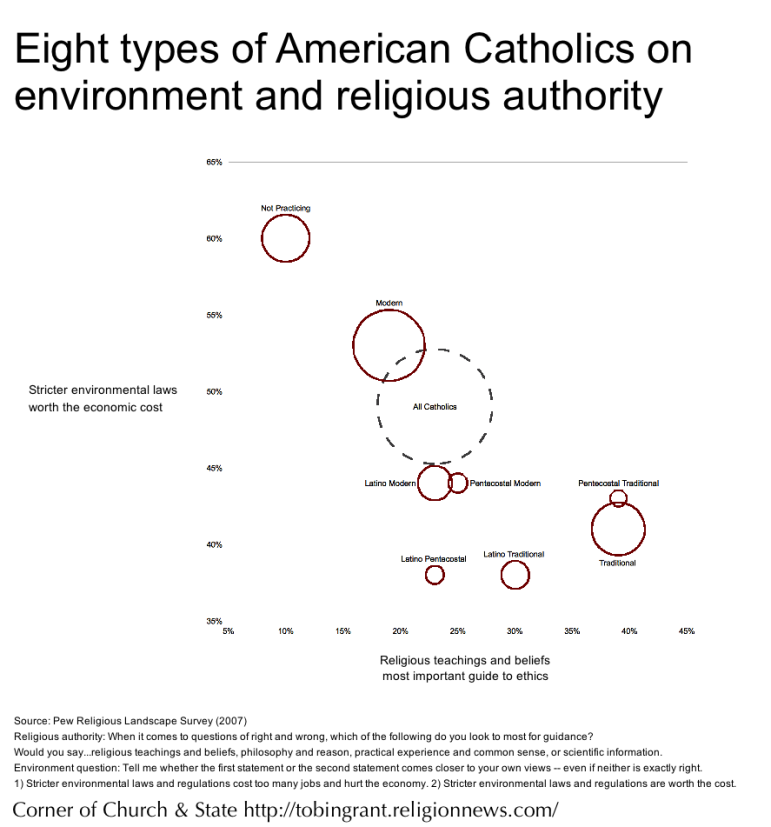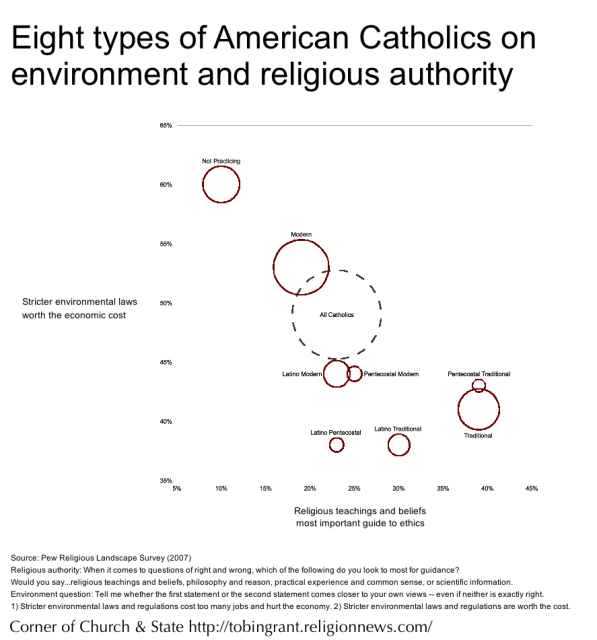Pope Francis’ encyclical on the environment raises a conundrum for American Catholics: those least likely to support calls to protect the environment are the same Catholics who say that their faith is the foundation of their ethics.
U.S. Catholics may be members of one church, but there are divisions along theology, ethnicity, and culture. Using Pew’s Religious Landscape study, I compare eight different types of Catholics (details below) on two dimensions.
- Religious authority. Pew did not ask a question about the authority of the Catholic Church, but it did ask people what guided their decisions over right and wrong. A majority of Catholics said they relied on their personal experience, but 23 percent said it was religious teachings and beliefs.
- Environmental regulations. The Pew survey gauged the general position on environmental regulations by asking people to choose if they believed that “stricter environmental regulations cost too many jobs and hurt the environment” or that “stricter environmental regulations were worth the cost.” By a two-to-one margin, Catholics said regulations were worth the cost.
Differences between types of Catholics should make reactions to the encyclical fascinating to watch. Catholics who look to the Church for moral authority may find the encyclical running against their politics, while those who like the politics are less likely to see their faith as guiding their values.
Takeaways from the graph
- Catholics who are not practicing and Catholics who see their faith as needing to adjust to modern life back environmental regulations. But both of these groups are less likely to say that their views on right and wrong are based on their religion.
- Traditional Catholics say that they base their ethics on their faith. These Catholics, however, are less supportive of environmental regulation.
- Among modern Catholics, Latinos and pentecostals are less supportive of regulations even though their views on moral authority are about the same.
- Latinos who are pentecostal or traditional Catholics are the least supportive of environmental regulations.
See a graph of the politics of American Catholics
See a graph of the foreign policy positions of American Catholics
Getting to eight types of Catholics
I’ve broken down Catholics into eight types. There’s no magic reason to have nine and not four, six, or a dozen. But these eight groups are based on some notable splits we find among American Catholics. Together, these four overlapping divisions define the eight groups.
1. Practicing vs. Not Practicing Catholics
Some people are culturally Catholic but are not active in their religion. They were born (and baptized) Catholic and may have been raised Catholic. As adults, however, they do not participate in the life of a local parish. For my purposes, I used a low bar to place people into the “not practicing” category. Catholics who attend even a few times a year are, at least in this study, considered practicing.
2. Traditional vs. Modern Catholics
One of the challenges among Catholics is how to bring together the church’s tradition with modern life. Traditional Catholics are those who believe the Church should “preserve its traditional beliefs and practices.” In contrast, modern Catholics are those who believe that the church should “adjust” to modern life or even “adopt modern beliefs and practices.”
3. Latino Catholics vs. other ethnic Catholics
Latinos are one of the largest ethnicities within the American Catholic church. In many places, they are also one of the most recent immigrants. To be clear: not all Latino catholics are part of Latino congregations. Still, many are, and, for now, they represent a different flavor of Catholicism in America.
4. Pentecostal Catholics vs. other Catholics
Most pentecostals are evangelical Protestants, but there are also many Catholics who are pentecostal. Pentecostalism is a religious movement that emphasizing the active working of the Holy Spirit in the lives of Catholics, which believed to be manifest in miracles or speaking in tongues. Pentecostal Catholics often participate in services beyond the traditional mass, services that feature contemporary, energetic worship services. Pentecostal Catholics are a growing movement with the Church worldwide, just as they are within Protestantism.
Putting these four divisions together, I can identify eight types of Catholics in America:
- Not practicing
- Latino Pentecostal (includes both modern and traditional because of sample size)
- Latino Modern (does not include Pentecostals)
- Latino Traditional (does not include Pentecostals)
- Pentecostal Traditional (does not include Latinos)
- Pentecostal Modern (does not include Latinos)
- Traditional (does not include Latinos or Pentecostals)
- Modern (does not include Latinos or Pentecostals)
Don’t miss any more posts from the Corner of Church & State. Click the red subscribe button in the right hand column. Follow @TobinGrant on Twitter and on the Corner of Church & State Facebook page.






